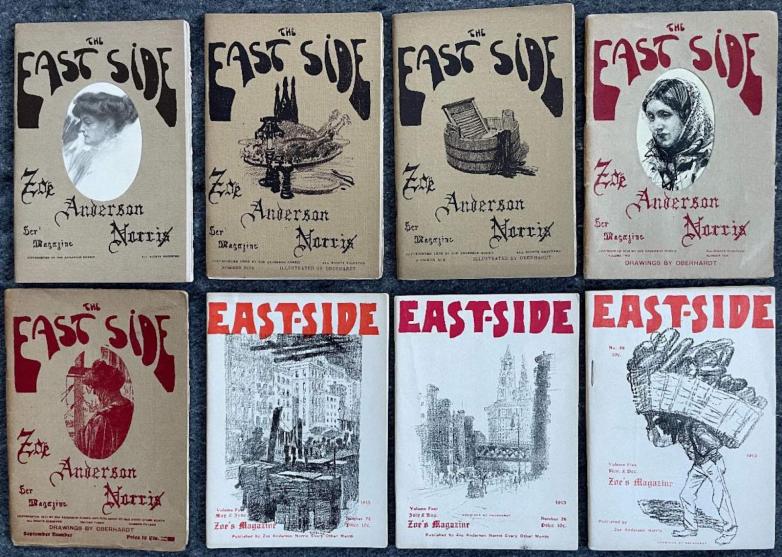Forgotten Gilded Age Author Zoe Anderson Norris to be Celebrated

Some of the 29 issues of The East Side, Zoe Anderson Norris’s magazine, 1909-1914.
Zoe Anderson Norris (1860-1914), although little remembered today, was a foremother of modern-day social-justice advocates and confessional bloggers baring souls in print. In millions of published words of fiction and journalism - including in her own bimonthly magazine, The East Side (1909-1914) - she documented desperate immigrant poverty in New York and called for the world to heed and help. The Grolier Club in New York City, America’s oldest and largest society for bibliophiles, will celebrate Norris’s legacy with an exhibition curated by independent scholar Eve M. Kahn To Fight for the Poor with My Pen: Zoe Anderson Norris, Queen of Bohemia on view in the Club’s second-floor gallery from March 2 to May 13, 2023.
A Kentuckian belle turned restless Kansan housewife turned “Queen of Bohemia” in Manhattan, Norris covered issues that still resonate: corrupt policemen harassing street peddlers, powerful male editors going unpunished for plagiarism or sexual assault, trafficked sex workers futilely pleading for help escaping the streets. Norris’s goal: “To fight for the poor with my pen.” Sometimes she reported undercover, dressed as a blind beggar or a stranded tourist, to gauge reactions from policemen and philanthropists. She went broke as she wrote about poverty, battling incompetent printers and distributors, and granting herself all East Side masthead titles including bootblack, circulation liar, and “the whole shebang.”
“I have collected evidence of Zoe’s prolific output, her bravery and foolhardiness, in and out of disguise, defending the vulnerable while so vulnerable herself,” said Kahn, who is writing the first biography of Norris. “I call her ‘the Nellie Bly you’ve never heard of.’”
The Grolier Club’s exhibition will draw on approximately 100 objects from Kahn’s collection, shedding light on how Norris mined raw material from her childhood and youth in rural Kentucky and Kansas, and her two bad marriages, while feeling most at home among other outsiders in New York. With her trailblazing one-woman company, she focused on the sufferings and strivings of recent arrivals, mainly from Eastern Europe and Italy. She called for government reforms, whether to remove disease-inducing trash from slum streets or feed starving families.
Subscribers to her magazine (at $1 a year) could also join an intentionally disorganized and joyous group that she founded, the Ragged Edge Klub. At their weekly restaurant dinners, a wine bottle served as a scepter as bohemia’s queen gave out titles to her artistic and musical friends, such as Baron Bernhardt of Hoboken and Lady Betty Rogers of the Bronx (wife of the comedian Will Rogers). On Friday, February 13, 1914, Norris died of heart failure, just after mailing out an East Side issue with an essay on her recent dream of her imminent death. The news of her accurate premonition made headlines in about 200 newspapers, and then she lapsed into undeserved obscurity.
Kahn said, “My proposed biography title is Queen of Bohemia Predicts Own Death, quoting from her obituary headlines—the foreshadowing was the least of her accomplishments, but one that’s been better documented than her life and work, until now.”
Exhibition Highlights
To Fight for the Poor with My Pen documents Norris’s astonishing productivity in a career that lasted less than two decades—her mantra was “work, damn you, work!” On view are The East Side’s 29 issues, with illustrations by the artist William Oberhardt (later renowned for covers of Time magazine); Norris family photos and memorabilia; publications by like-minded activists such as Emma Goldman; and Ragged Edge Klub ephemera including sheet music and restaurant dinnerware.
The full run of The East Side - the only such collection known to survive in private hands - shows Norris maintaining a sense of humor and wonder. She marveled at skyscrapers “flashing back the fire of the sun,” as she battled “so many wrongs that should be righted” of immigrants’ mistreatment at the hands of tenement landlords and toxic factories’ owners. The East Side’s die-cut covers, Art Nouveau typefaces, and Oberhardt’s images of skyscrapers, market stalls, and laborers gave the publication a distinctive appearance on the newsstand, in an age of burgeoning creativity in magazine design.
The Ragged Edge Klub posed for group photographs in The East Side during occasional breaks from uninhibited dancing, often to tunes supplied by the Black composer and pianist Harry Huggs. Norris became such a nightlife fixture that at least one favorite Ragged Edge restaurateur hung up her portrait, and the exhibition features a restaurant advertisement depicting Norris on the wall.
Also on view are copies of Norris’s three novels, in which characters cope with impoverishment in Europe, New York, and rural Kansas, that previously belonged to celebrities such as Richard Le Gallienne, one of Oscar Wilde’s lovers. Kahn’s collection of periodicals featuring Norris’s writings includes enduring titles such as Harper’s and Woman’s Home Companion, as well as lavishly illustrated, short-lived magazines like Four o'Clock and The Clack Book.
The exhibition also will place Norris in the context of her era’s progressive publishers and authors, featuring writings by the philosopher Elbert Hubbard; Sophie Irene Loeb, who headed New York’s Board of Child Welfare; and Emma Goldman’s Mother Earth magazine.















